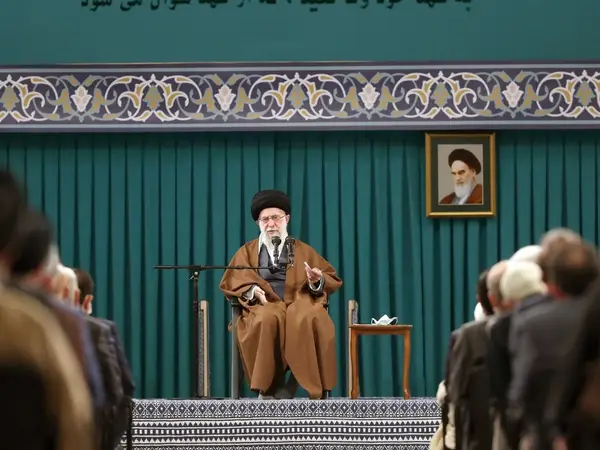Iranian pundits and critics have been busy reviewing two Ramadan gatherings this week in Tehran to read into politics and politicians in the Islamic Republic.
An April 12 iftar (Ramadan fast breaking) at the Islamic Republic Leader Ali Khamenei's house and a similar party at the office of the Iranian President Ebrahim Raisi on April 10, attracted a lot of media attention for the wrong reasons.
Such banquets are annual traditions of the Leader and President's office during Ramadan. For the hosts, it is a show of their grandeur and their support base among the elite. For the guests it is an opportunity to show off their connections with men of power. For the privileged photographers it is a chance to highlight anything that is odd, interesting, or out of the ordinary.
The meeting with Khamenei turned out to be controversial the following day as his office corrected part of his speech in which he had praised "the progress in the nuclear negotiations." The correction changed it to "progress in Iran's diplomacy" in general.
Other than that, the most important thing about the meeting at Khamenei's house was the photographs that could provide ammunition for analysts whose work is based on the cold war model of Kremlinology, that is playing with the slightest nuance and body language that could mean something consequential.
The photographs showed, among others, former president Hassan Rouhani and former foreign minister Mohammad Javad Zarif. Many hardliners would have preferred not to see them again anywhere near Khamenei. One social media user opined that their presence was like bathing them with water and soap and cleansing them of the charges that could have landed them in jail.
This was a reference to the fact that hardliners who blame Rouhani for all the failures of the regime, have been calling for his prosecution. Others assumed that Zarif's statement in a leaked audio last year in which he said the IRGC carried out Russia's orders, would permanently kick him out of the elite Khamenei accepts.
Others seen in photographs included former Majles Speaker Ali Larijani and his brother Former Judiciary Chief Sadeq Amoli Larijani. The former was believed not to be an insider any longer following his disqualification as a candidate in the 2021 presidential election and the latter was accused of financial corruption.
It was significant that Rouhani and Amoli Larijani were sitting in the first row in front of the Supreme Leader. Everyone had assumed that both had been banished by Khamenei for the foreseeable future.
Another notable point about Rouhani was that he was the only former president at the meeting. Reformist Mohammad Khatami and Mahmoud Ahmadinejad were nowhere to be seen.
Like this meeting, which was attended by almost everyone who is anyone in Iran, the April 11 meeting at Raisi's office was attended by hardliners as well as pro-reform media and political figures. The juxtaposition was best highlighted by the pictures that showed pro-reform editor of Sazandegi newspaper Mohammad Ghoochani in friendly scenes with hardliner Kayhan newspaper's firebrand editor Hossein Shariatmadari.
This probably showed a high-level decision not to ignore the so-called reformists who have lost a lot of popularity. The result was to see characters like the two editors under one roof. Many social media users pointed out the fact that these characters with their “sham conflicts” in their papers and their friendly gestures in the photos are “birds of the same feather” and it is meaningless to talk about them as representing diagonally opposing political factions in the Islamic Republic.
